Trump's 2025 Tariffs: Tech Disrupted, Trade Rewired
Apr 30, 2025
Some thoughts don’t come gently-they crash in, urgent and electric. This one hit me on a rainy Friday evening, cycling from HAL side roads to Doddanekundi, Sam Altman’s podcast in my ears, Bengaluru’s chaos all around. I’ve followed AI closely ever since my Ph.D. days at IITH in 2019-when Generative AI was just starting to stir up debates, and my first project with an LSTM-based summariser felt almost magical.
Back then, none of us could have pictured how wild and personal this wave would become. Now, in 2025, it’s everywhere-every signal, every chai break, every “naukri jaayegi kya?” WhatsApp forward.
So here’s a 2025 to 2050 vision-call it a forecast, a peek ahead, or just a heartfelt warning. These aren’t just hot takes from a tech newsletter, but living observations-stories from the ground, questions that kept me up at night, and changes I believe every friend, parent, and dreamer should notice. This might be the most important thing I’ve ever tried to write (and yes, I had some help from a transformer algorithm this time).
Pour your chai, take a breath-let’s look at the next 25 years together, honestly, curiously, and with a bit of desi jugaad.
That evening, chai in hand and ceiling fan spinning, I realized these questions… jobs, meaning, future: aren’t just mine. They’re everywhere, swirling through boardrooms, podcasts, and WhatsApp groups.
The world is full of what I call millennial sages: Sam Altman dreaming of a future so abundant that paisa won’t matter; Yuval Noah Harari writing philosophy for an age where language itself is up for grabs; and, of course, Elon Musk, who exists somewhere between meme and messiah, always with one hand on the emergency brake of technology.
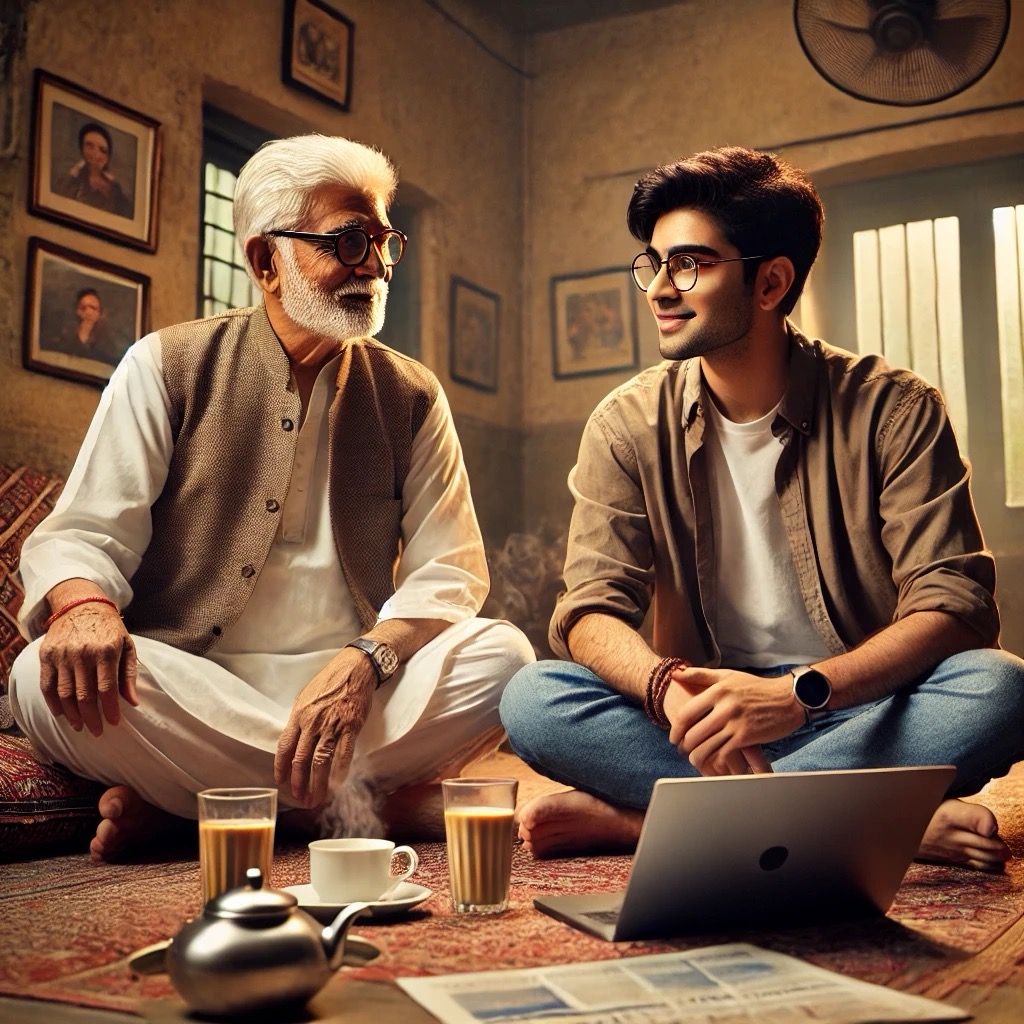
Dadaji meets the future. AGI and old salary worries.
And then there’s Geoffrey Hinton-not a millennial at all, more like the last ancestor in the land of digital monks. Hinton stands apart because his warning is stark and sobering:
“Humankind has never before dealt with something that’s intellectually superior to itself.”
He reminds us: This isn’t like dealing with fire, electricity, or even nuclear bombs. This is a whole new territory, and the margin for error is thin. Governments and regulatory bodies, Hinton says, must tread with more care and humility than ever before-because once the genie is out, you don’t just put it back.
Even the consultants-McKinsey, WEF-have joined in, tossing stats like confetti: “Forty to sixty percent jobs will change.” For them, it’s a spreadsheet; for us, it’s the anxious voice note from a cousin after layoffs, the taste of cold upma after a dud placement.
The debates aren’t just about tech-they’re about how society responds. In Europe, Canada, and Australia, the idea of Universal Basic Income (UBI) is slowly turning from theory to policy. But in the US, Russia, China, and India, it’s more like a political game of snakes and ladders-sometimes promising, sometimes impossible, always unpredictable.
This is where my small world and the millennial sages finally collide. And maybe, with all this noise-some of it ancient, some painfully new-we’ll finally hear what matters.
As Dadaji would remind us, and the Sanskrit wisdom says:
“उद्यमेन हि सिद्ध्यन्ति कार्याणि न मनोरथैः।
न हि सुप्तस्य सिंहस्य प्रविशन्ति मुखे मृगाः॥”
(Only through effort are tasks accomplished; deer never walk into a sleeping lion’s mouth.)
Effort beats wishful thinking, no matter how futuristic the world gets.
Disruption isn’t some abstract conference topic anymore. It’s the ping of a layoff email, your cousin Neha in Hyderabad texting, “bhai, kuch naya seekh lete hain kya?”, and your mom’s gentle “सब ठीक है ना, बेटा?” after seeing news of IT layoffs. By 2027, the first AI wave is unmistakable-especially in Indian IT, legal, BPO, and other “template” jobs. Suddenly, ChatGPT and friends aren’t just headlines-they’re the new office gossip.
Everywhere, reinvention is in the air. Naman and Priya (yes, the same duo from Koramangala cafés) are a classic Bengaluru pair: Naman still dreams of a fintech unicorn; Priya is just relieved to have landed a role in an AI-powered edtech after being let go from her old BPO job.
This decade belongs to those who act, adapt, and start before anyone gives them “permission.”
Kabir’s ancient urgency rings true:
“काल करे सो आज कर, आज करे सो अब।
पल में परलय होएगी, बहुरि करेगा कब॥”
(What you plan to do tomorrow, do today; what you plan to do today, do now. Who knows when the world may end?)
Today’s hustle is tomorrow’s survival.
Take Mihir-once a QA tester at a tech MNC, now running “CodeWithChai,” a YouTube channel that helps freshers transition from manual testing to AI prompt engineering. In just a year, he’s freelancing for a US-based non-profit and mentoring teens in Coimbatore who want to build their own chatbots. Mihir’s father still asks, “Beta, sach mein kaam karta hai ya sirf camera ke saamne baithta hai?”
Meanwhile, governments are caught in the crosswinds:
While European cities experiment with trial UBI schemes and Canada debates “AI transition funds,” India’s answer is classic jugaad-more online reskilling programs, a dash of gig work, and a whole lot of waiting to see what the US and China do next.
Degrees and certificates still matter, but the world’s now run by those who can keep learning, adapt, and surprise everyone.
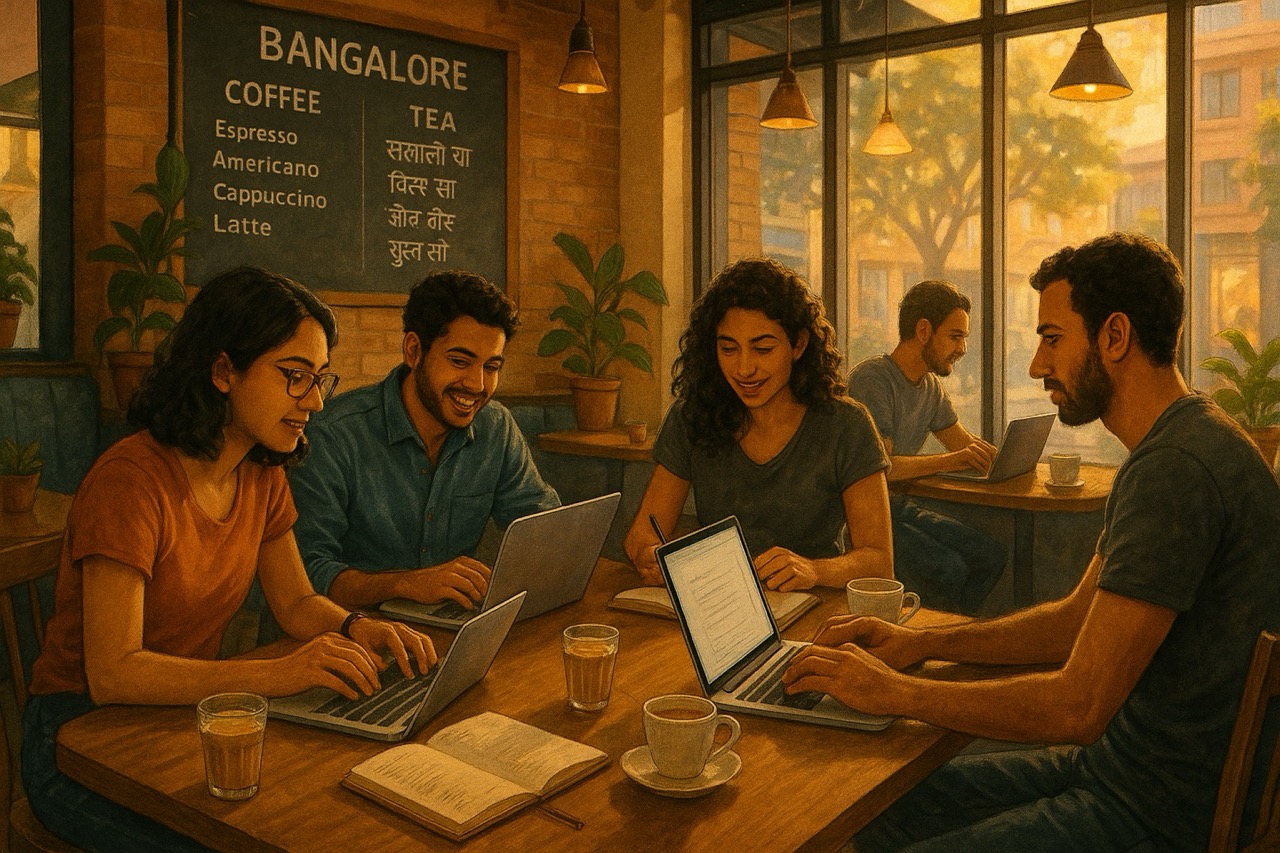
The new classroom. Where ideas-and AI startups-are brewed with every cup of coffee.
By the 2030s, AI isn’t something you “use”-it’s something that’s just there, like Wi-Fi and street dogs in Bangalore. In Mumbai, Shweta, now a history teacher, surprises her students by saying: “I’ll give more marks for the best question than for the best answer-use whatever AI tool you want.” Meanwhile in Bhubaneswar, Tapan the solar techie livestreams his inverter hack, gets a “Jhakaas!” from someone in Warsaw, and a “bhai, epic!” from his old hostel friend on WhatsApp.
Work is now a duet between human dreams and machine muscle. Prompt engineers-like Rishabh in Delhi-are the new poets, always tweaking, always tuning. Teachers become curators, helping students learn not just to answer, but to experiment, stumble, and get back up. Even Arjun in Vidarbha, who farms with one eye on the sky and one on his dashboard, knows: “Data se batao, lekin mitti ko bhi pooch lo!”
Urban India is one big hackathon, digital mandali, and chai pe charcha. The “cool” thing isn’t being a topper-it’s building, remixing, and quietly launching a new thing every quarter. The most impressive résumés are the ones that show curiosity, not just degrees.
But here’s the real lesson: Collecting certificates is easy-living wisdom is rare.
As Kabir says:
“पोथी पढ़ि पढ़ि जग मुआ, पंडित भया न कोय।
ढाई आखर प्रेम का, पढ़े सो पंडित होय॥”
(Reading endless books, people died wise in none. He alone is learned who understands the two-and-a-half letters of love.)
The heart, humility, and sharing spirit matter more than any “AI super-user” badge.
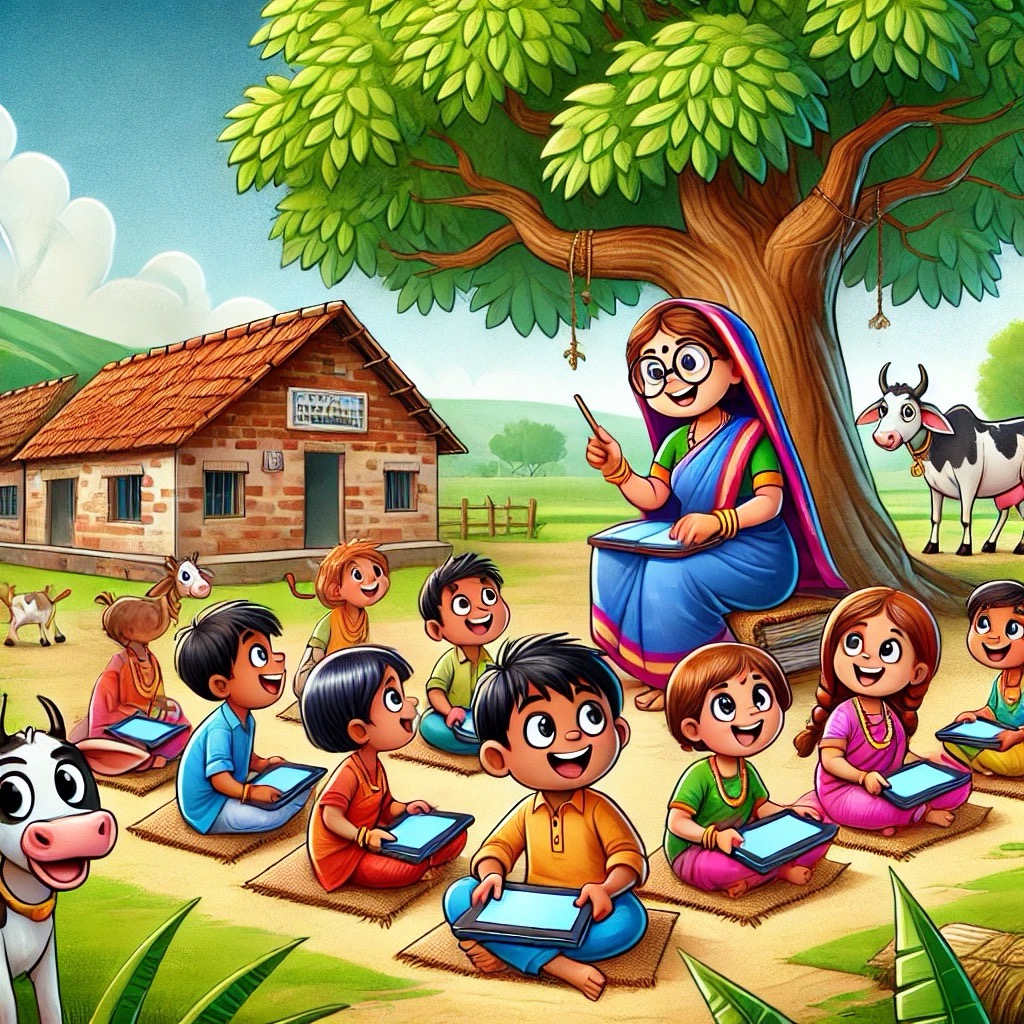
AI and neem trees: India’s new learning revolution has no walls.
By 2040, AI is as invisible and essential as electricity or monsoon humidity. Your fridge orders milk before you even think of chai. Playlists sense your mood. Kids fall asleep to stories about grandma’s Odisha village and a Mars colony, both spun by a cheerful bot.
Work, finally, is about choice more than compulsion. Universal basic income becomes a reality in parts of Europe, Canada, and Australia-friends like Andre in Berlin joke about “paid sabbaticals for everyone.” But in the US, Russia, China, and India, politics means UBI comes and goes like a cricket score-debated, delayed, sometimes piloted in small towns, never a national promise.
The real magic? Old India and New India meet every day:
Saniya, who designs “digital seva” bots for temples, also leads art therapy sessions for seniors; Irfan, who once managed a tiny cycle repair, now runs a drone repair hub in rural Odisha, and guides Rath Yatra pilgrims worldwide in virtual reality.
Lines between city and village, human and machine, creators and caretakers blur. It’s not about who controls AI, but who can connect, care, and build with it.
Ancient Indian wisdom suddenly feels like a prophecy:
“अयं निजः परो वेति गणना लघुचेतसाम्।
उदारचरितानां तु वसुधैव कुटुम्बकम्॥”
(The narrow-minded see ‘mine’ and ‘yours’; for the open-hearted, the whole world is family.)
Tech may break old boundaries, but unity and empathy are still what hold us together-across mohallas, time zones, and digital platforms.
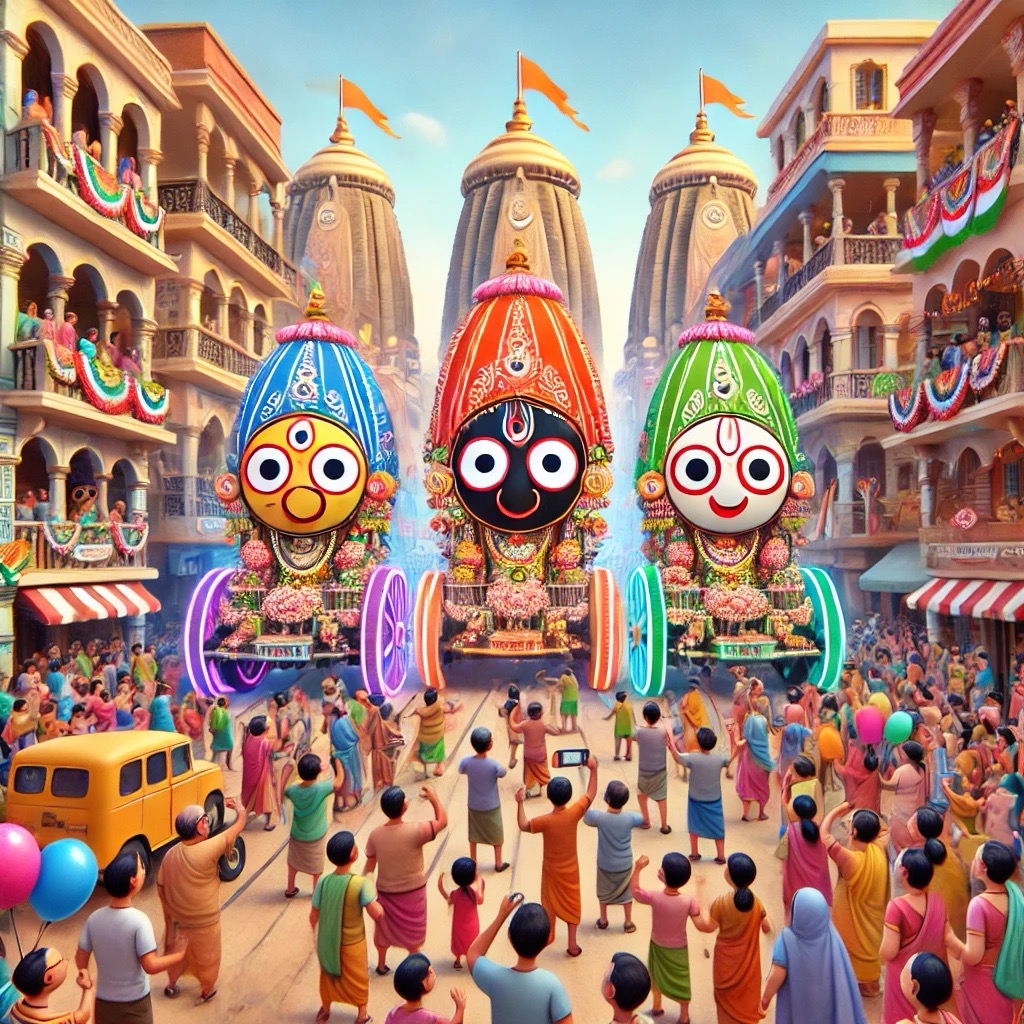
Tradition meets tech: Rath Yatra 2040 in VR, where every journey is shared.
By 2045, the job market feels like musical chairs at a wedding baraat-some seats gold-plated, others snatched away as the tune changes. The safest roles? The ones that nobody can fully “code up”: empathy, creativity, hands-on intuition. No AI replaces Raghav the counselor, who listens without judging, or Meera, the special ed teacher, who spots the silent question in a student’s eyes.
But the world keeps morphing. Tanya, who once managed call centers, now runs yoga and wellness sessions through a hybrid of AI chat and real-time group calls. Her old teammate, Vikas, once translated technical docs; now he’s a “prompt designer,” making bots understand context and “feel” in five Indian languages. Even agriculture evolves-farmers like Arjun in Nashik run their own data dashboards, but always walk the fields at dusk to feel the crop between their fingers.
The real edge?
It’s never just what you know-it’s how you learn, adapt, and lift up others around you.
Our ancestors got this right generations ago:
“विद्या ददाति विनयं विनयाद् याति पात्रताम्।
पात्रत्वात् धनमाप्नोति धनात् धर्मं ततः सुखम्॥”
(Knowledge gives humility; humility brings worthiness; worthiness brings wealth; wealth brings righteousness, and righteousness brings happiness.)
It’s the cycle that never fails: learn, stay humble, help others rise, and real rewards follow.
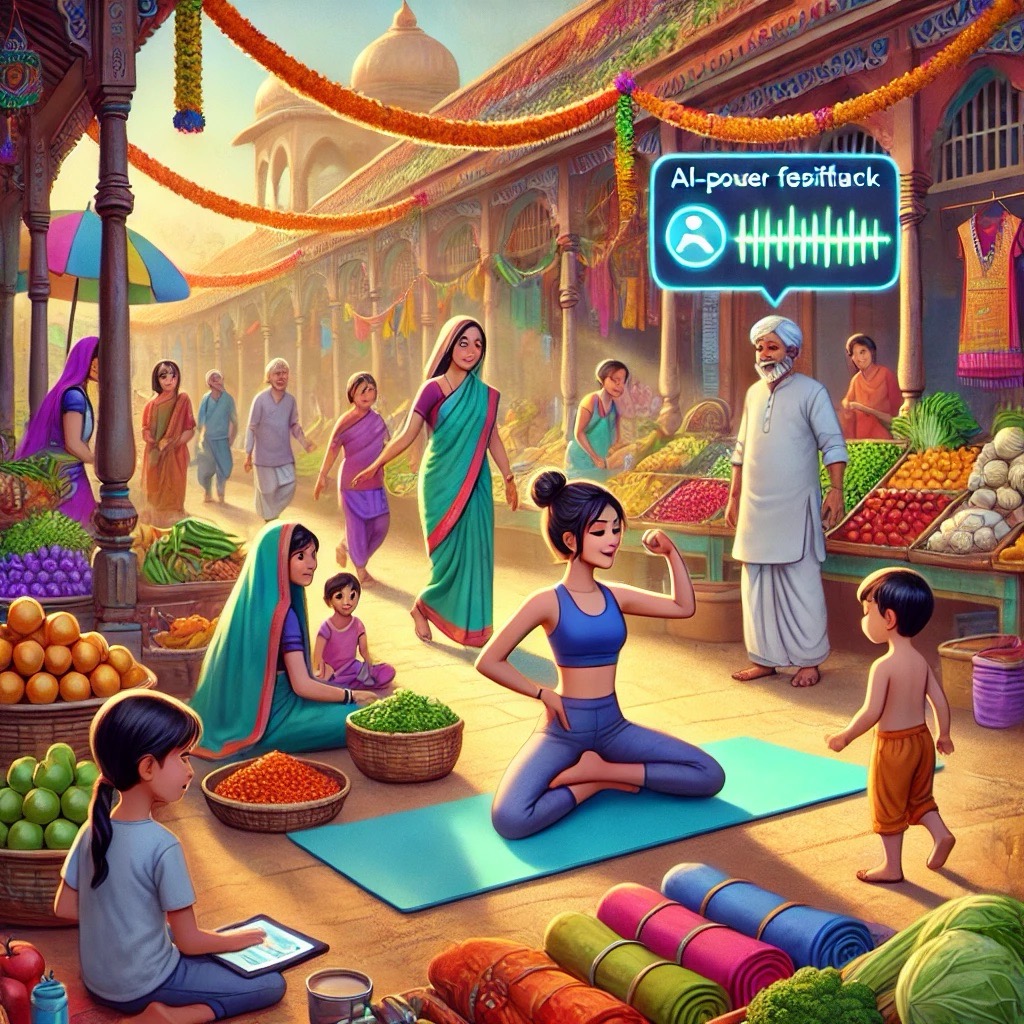
Reinvention at work: From call center to wellness guru, under the open sky.
So what now? Life ahead is not a straight highway-it’s a maze of crossroads, potholes, and the occasional rooftop party. In the years ahead, you’ll juggle learning, hustling, side gigs, maybe teaching or mentoring, building online and offline communities-and sometimes just taking a breath to see how far you’ve come.
Parenting, for many, will mean raising kids fluent in both machine and human languages, curious, capable of failing and laughing and building again. If you’re not raising kids, maybe you’ll help a neighbor, or an old friend, or some future “CodeWithChai” follower find their own path.
Money? The best plan is still Grandma’s: Save smart, invest steady, never gamble what you can’t lose, and don’t fall for shortcuts-especially in a world where even the “sure thing” can be upended by the next breakthrough.
But most of all-don’t let the world pass by while you just watch from the sidelines.
If you remember nothing else from this whole winding blog, let it be this:
“सिर्फ़ तमाशबीन मत बनो-ज़िंदगी के मंच पर खुद भी कोई नया किरदार बनो, यार!”
(Don’t just be a spectator-on life’s stage, become a new character yourself!)
Ceiling fan ki kasam, go out there, build something wild, laugh at yourself, and help someone along the way.
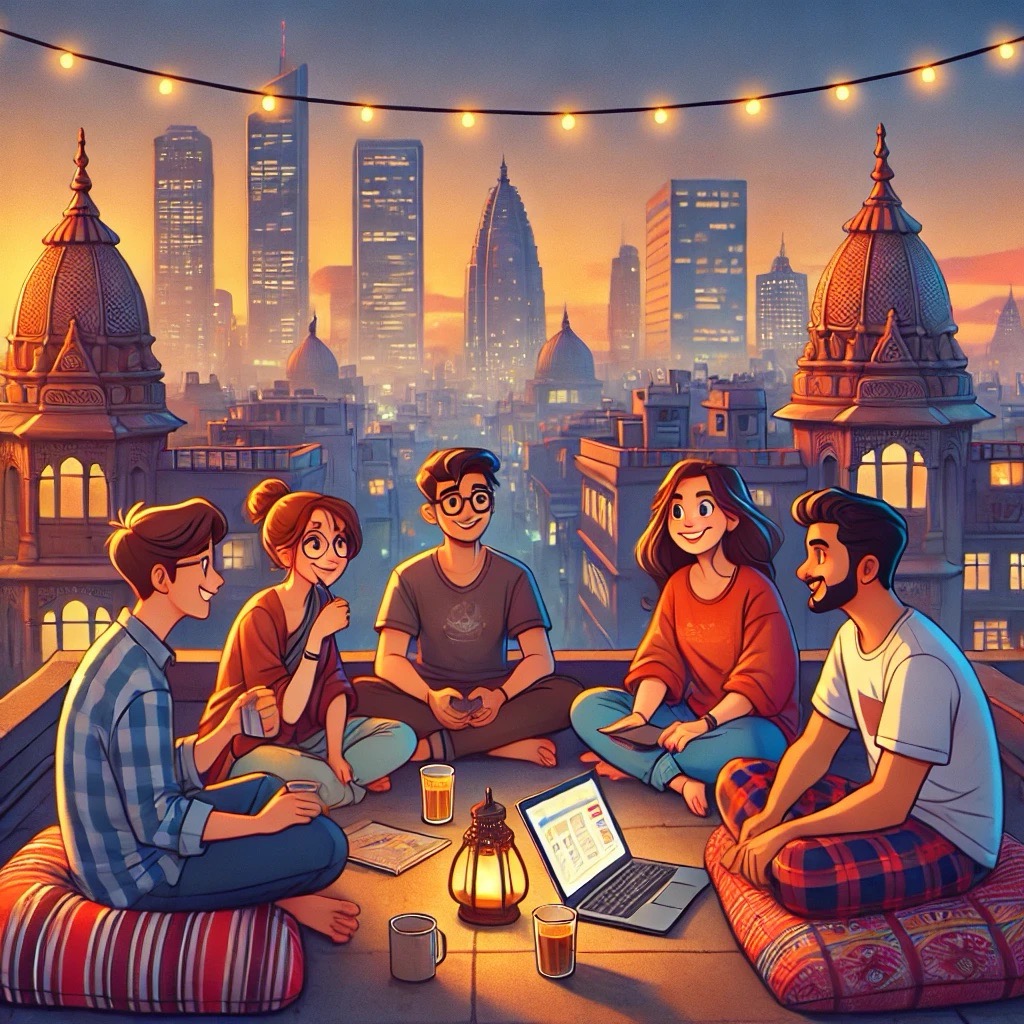
Old friends, new dreams-the journey is just beginning.
If you found something in this post that sparked a thought or an itch to build, don’t keep it to yourself!
Share this blog with a friend/family, bring it up at your next chai break, or debate it with that one uncle who still calls AI “magic.” Tell me what you’re seeing-on your campus, in your office, or from your terrace at midnight.
If you disagree with my predictions? Even better.
Comment, DM, or just write your own post. The more voices, the better this future will be.
Because, in the end, ज़िंदगी के मंच पर सबका किरदार ज़रूरी है-everyone has a part to play.
Bhargav Achary is a curious engineer, part-time storyteller, and lifelong chai lover. He has been exploring AI, tech, and society since his Ph.D. days at IIT Hyderabad, sometimes late at night, usually with a playlist of Lucky Ali and the steady hum of a ceiling fan in the background.
Bhargav’s writing is rooted in real experience-hostel corridors, Bengaluru traffic jams, and quiet moments between lines of code.
He believes that tech is best understood through stories, and that every big trend (AI included) is really about how people adapt, learn, and lift each other up.
Want to connect, argue, or swap AI jokes?
You’ll find him at BhargavAchary.in still sipping chai and still asking: What’s next?
More Posts